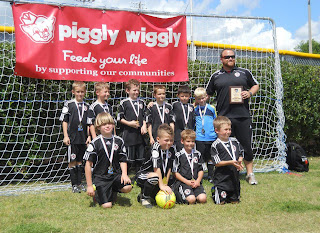So...the end is in sight. The holidays are just around the corner. You already have visions of yummy turkey legs and maybe even sugarplums bouncing around your head. How do you feel? Raise your hand if you thought "Relieved!" It's okay. It's been a long 4 months or so. You can be a little tired. We aren't over yet, but its coming. So strap in, stay focused, and have fun while you finish up Fall 2012.
For those of us coaching the u4's up to the u12's....keep in mind that it's not all about where you are in the standings come that final whistle of your last match. At these levels, its about cultivating a relationship with the game and a loving bond with the ball. If your kids go home each day smiling and come back every week ready to go, then you are doing a great job. So be proud of yourself. Take pride in the fact that you, coach, are helping to grow this game in a positive way.
So with just a few weeks to go....have lots of goofy fun! Play games and focus on building team spirit. Many of the kids will head off to basketball, hockey, or flag football for the Winter break. And that's ok. Sure, soccer can be played year 'round. Futsal or indoor soccer calls many players to continue to feed their obsession. But these other sports teach our boys and girls valuable skills that they will surely use when they strap their boots back on and get back on the pitch this Spring.
If mom or dad asks what you think they should do, tell them to take a little break. Play another sport. Reenergize. Come back to soccer fresh and ready to play. Yes, I know...Blasphemy, right!?!? Ok, if you just cannot stay away...or if maybe you have an Academy or Select team, then plan to have a couple of sessions just to kick around over the break. Give them a little bit of homework here or there. Maybe offer a pizza party if every player reaches a juggling goal. Whatever you decide to do, your goal should be to avoid burnout and keep those kids loving the game. What is that saying, "If you love something, let it go..."?
To recap -
- Thanks for what you do!
- Play lots of silly games to end the season. My favorites are:
- Head/Catch - line the players up or stand in a circle (with you in the middle) and yell out Head or Catch while you toss the ball at the players. They must do the opposite of whatever you say. Head = catch with their hands / Catch = head the ball back to coach
- Duck, Duck, Goose - simple enough, right!?! same as you remember, but the player walking around the circle is dribbling a ball. Once they choose a goose that chases them, they have to dribble as fast as they can around the circle (while retaining possession of the ball) to sit in the Goose's spot.
- The Farmer & The Foxes - Foxes tuck flags (pinnies) in the back of their shorts as tails. Farmer tries to grab the tails. Foxes try to avoid losing tail by running around in penalty area and turning, etc. Once a fox loses his tail, he becomes a farmer.
- · Make more complicated by having foxes also dribble a ball. This gives them two lives. Farmers must grab tails and kick balls out of square.
- Let the kids take a break from soccer for the Winter.
Thanks again for being who you are and doing what you do. Coaching, there is nothing more rewarding!

















